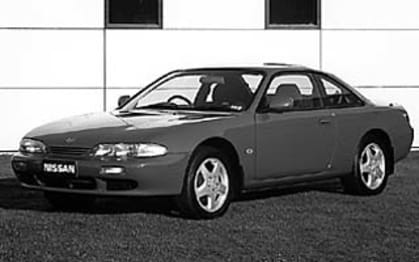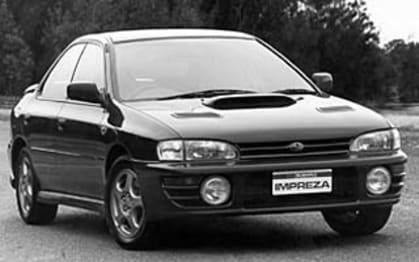
Used Nissan 200SX review: 1996-2003
- Nissan 200SX
- Nissan 200SX 1996
- Nissan 200SX 1997
- Nissan 200SX 1998
- Nissan 200SX 1999
- Nissan 200SX 2000
- Nissan 200SX 2001
- Nissan 200SX 2002
- Nissan 200SX 2003
- Nissan 200SX Reviews
- Nissan Reviews
- Nissan Coupe Range
- Coupe
- Nissan
- Used Car Reviews
- Buying tips
Who says looks don’t sell cars. Take Nissan’s brilliant 200SX turbocharged coupe for example. Few cars in 1996 could match its performance, but few people tuned in because of its bland looks.
There wasn’t much on offer in 1996 if you wanted a performance car. Holden had its V8 SS, Ford had its XR6, Mazda its little MX5, but that was about the extent of the choices before the 200SX and the turbocharged Subaru WRX came on the scene.
With the arrival of the new turbo cars sports car buyers had the choice of two cars that delivered unprecedented performance for the price.
The WRX was a more radical model heralding a new type of performance car to the market, while the 200SX was a more conventional sports coupe.
The updates to the 200SX in 1996 and 2000 enhanced what was under the skin a very good package with a more aggressive look and a longer list of features.
Model watch
The 200SX story begins with the launch of the all-new S14 model to the local market in 1994 when it took the performance segment by storm.
Subaru had only just launched the WRX which would lead the turbo revolution, so the 200SX presented an appealing proposition to anyone who wanted an attractive sports coupe that backed up its sporty looks with sporty performance, and at a reasonably affordable price.
If the first 200SX was a popular pick, the updated model in 1996 sharpened the package.
While the first model had the performance it was a fairly bland looker. Its lines were soft and rounded; they simply lacked the aggression expected of a car of its type.
That changed in 1996 with the release of the first update when its lines were sharpened, it was given a new grille and headlamps and a much meaner stance. All of a sudden it was a car that commanded your attention.
Under the sharp new skin lay the same 2.0-litre double overhead camshaft turbocharged four-cylinder engine. With 147 kW on tap at 6400 revs and mountains of torque from way down in the rev range the 200SX was quite a performer with the power to reach 100 km/h in around six seconds and cover the standing 400-metre sprint in 15 seconds.
One of the problems that plagued many early turbocharged cars was turbo lag, but there was none in the 200SX, and the engine was silky smooth right through the rev range.
Either a five-speed manual gearbox or a four-speed auto backed up the S14, with the five-speed being replaced by a six-speed in the S15 of 2000.
Drive went through the rear wheels, which gave the 200SX its great appeal. While it handled with impressive poise and great road holding it could be driven on the throttle and it was always possible to induce oversteer for a really fun ride.
If there was a criticism of the 200SX it was the ride, which could be hard and harsh, particularly in the sportier versions like the S15 Spec R.
In the S14 Nissan offered 200SX in Sports Limited, Sports and Luxury versions of the 200SX. In the Sports Limited model you got alloy wheels, air-conditioning, cloth trim, central locking, a driver’s airbag, and an alarm.
Add a rear spoiler, ABS, and leather trimmed steering wheel and gear knob and you had the Sports model; then add a passenger’s airbag, CD player and a sunroof and you were in a Luxury model.
With the S15 model change the choices became the Spec S and Spec R. The S had plenty of fruit, including alloys, ABS, air-con, central locking, immobiliser, CD player, and dual airbags; the sportier R came with rear spoiler, side skirts, sunroof, and six-disc CD player.
GT versions of the S and R models released in 2002 were dressed up with leather trim, chrome alloy wheels, drilled racing pedals, chrome door handles and a ‘performance’ rear wing.
Sadly the 200SX vanished from our showrooms in 2003 when Nissan moved to the 350Z.
In the shop
The 200SX has an enviable record in service. It’s a fundamentally sound sports car and will stand quite a pounding from enthusiasts with no outward sign of distress.
The turbocharged engine stands up well, but turbo engines generally need more servicing because of the harsh environment they operate in so look for signs that servicing hasn’t been done as often as it should.
Lift the oil filler cap and inspect for sludge inside the cover, pull the dipstick and check the colour of the oil, which should be clear without any visible contaminants.
The six-speed gearbox fitted to the S15 is noisy, has been from day one, but it doesn’t appear to translate into a mechanical problem.
Check the clutch, there should be about 25 mm free-play at the top of the movement, and it should fully disengage at the bottom of the stroke. If gears are hard to select there could be a problem with the clutch, and clutches take a pounding in cars like the 200SX.
It’s worth checking a car carefully for signs it has been used in motorsport. Check for holes in the bodywork that might have been used to mount a roll cage or fire extinguisher.
Look also for aftermarket modifications. Many owners fit larger turbochargers, larger intercoolers, and revised electronics among many modifications available to boost the 200SX’s performance.
In a crash
Agile handling, four-wheel discs, and ABS make a formidable package for avoiding a crash, but if a crash is unavoidable secondary protection is provided by airbags.
Owners say
Richard Salib has done 45,000 km in the 2002 200SX he bought new. He praises its razor sharp steering, excellent handling, sweet gearbox, and powerful engine which has “plenty of torque from just above 2000 rpm”, but is critical of its ride which can be harsh, its rawness in terms of refinement, and its low seating position which can limit visibility. Mechanically it has been “rock solid”.
Twelve months ago John Cusumano bought his “dream” car, a 2001 200SX Spec R that has done just 33,000 km. He loves the turbo performance without any lag, the handling and road holding, and the styling, but reckons they’re overpriced, and hard to handle in the wet, and he doesn’t like the noisy gearbox, and the loss of power in hot conditions. Like Richard’s car John’s has been very reliable.
Look for
• aggressive styling more in keeping with performance image
• tearaway turbo performance
• strong mechanical package gives little trouble
• noisy six-speed gearbox
• harsh ride on rough roads
• well balanced handling with good road holding
• caution needed with aftermarket updates
• avoid cars with clear motorsport use
The bottom line
Pound for pound there are few cars that can compete with the 200SX. Exhilarating performance and road holding at an affordable price.
Pricing
| Year | Price From | Price To |
|---|---|---|
| 2003 | $7,370 | $11,880 |
| 2002 | $4,180 | $11,880 |
| 2001 | $7,370 | $11,880 |
| 2000 | $3,190 | $11,880 |
| 1999 | $3,190 | $7,260 |
| 1998 | $3,190 | $7,150 |
| 1997 | $3,080 | $6,710 |
| 1996 | $3,080 | $6,710 |
Pricing guides
Range and Specs
| Vehicle | Specs | Price* | |
|---|---|---|---|
| Sports Limited | 2.0L, PULP, 5 SP MAN | $3,080 – 4,730 | 1996 Nissan 200SX 1996 Sports Limited Pricing and Specs |
| Sports | 2.0L, PULP, 5 SP MAN | $3,300 – 5,170 | 1996 Nissan 200SX 1996 Sports Pricing and Specs |
| Luxury | 2.0L, PULP, 4 SP AUTO | $4,510 – 6,710 | 1996 Nissan 200SX 1996 Luxury Pricing and Specs |
Other cars to consider
$4,510
Lowest price, based on third party pricing data


















